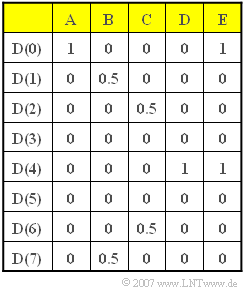Exercise 2.4Z: Repetition to IDFT
In the Discrete Fourier Transform $\rm (DFT)$ from the time samples $d(\nu) \hspace{0.15cm} {\rm with} \hspace{0.15cm} \nu = 0$, ... , $N - 1$ the discrete spectral coefficients $D(\mu) \hspace{0.15cm} {\rm with} \hspace{0.15cm} \mu = 0$, ... , $N - 1$ calculated as follows:
- $$D(\mu) = \frac{1}{N} \cdot \sum_{\nu = 0 }^{N-1} d(\nu)\cdot {w}^{\hspace{0.05cm}\nu \hspace{0.03cm} \cdot \hspace{0.05cm}\mu} \hspace{0.05cm}.$$
Here $w$ abbreviates the complex rotation factor, which is defined as follows:
- $$w = {\rm e}^{-{\rm j} \hspace{0.05cm}\cdot \hspace{0.05cm} 2 \pi /N} = \cos \left( {2 \pi}/{N}\right)-{\rm j} \cdot \sin \left( {2 \pi}/{N}\right) \hspace{0.05cm}.$$
Thus, for the Inverse Discrete Fourier Transform $\rm (IDFT)$ as an inverse function of $\rm DFT$:
- $$ d(\nu) = \sum_{\mu = 0 }^{N-1} D(\mu) \cdot {w}^{-\nu \hspace{0.03cm} \cdot \hspace{0.05cm}\mu} \hspace{0.05cm}.$$
In this exercise, for different example sequences $D(\mu)$ - which in the above table are denoted by $\boldsymbol{\rm A}$, ... , $\boldsymbol{\rm E}$ - the time coefficients $d(\nu)$ are determined. Thus, it is always $N = 8$.
Hints:
- This exercise refers to the theoretical foundations of the chapter "Discrete Fourier Transform" of the book "Signal Representation" and is identical to the one there "Exercise 5.2".
- You can check your solution using the interactive applet "Discrete Fourier Transform" .
- DFT and IDFT also play a major role in "DSM/DSL" .
- In the corresponding chapter, spectral coefficients are denoted by $D_k$ and time samples are denoted by $s_l$. We apologize for this nomenclature discrepancy.
- For the two running variables, with the DFT parameter $N = 8$: $0 \le k \le 7, \hspace{0.2cm}0 \le l \le 7 \hspace{0.05cm}.$
Questions
Solution
- $$d(\nu) = D(0) \cdot w^0 = D(0) \ = \ 1\hspace{0.3cm} \rightarrow\hspace{0.3cm}\underline{d(0) = d(1) \ = \ 1}.$$
This set of parameters thus describes the discrete form of the Fourier correspondence of the DC signal:
- $$x(t) = 1 \hspace{0.2cm}\circ\!\!-\!\!\!-\!\!\!-\!\!\bullet\, \hspace{0.2cm} X(f) = {\delta}(f) \hspace{0.05cm}.$$
(2) Here all spectral coefficients are $0$ except $D_{1} = D_{7} = 0.5$. It follows that for $0 ≤ \nu ≤ 7$:
- $$d(\nu) = 0.5 \cdot {\rm e}^{-{\rm j} \hspace{0.05cm}\cdot \hspace{0.05cm} (\pi /4) \hspace{0.05cm}\cdot \hspace{0.05cm} \nu} + 0.5 \cdot {\rm e}^{-{\rm j} \hspace{0.05cm}\cdot \hspace{0.05cm} (7\pi /4) \hspace{0.05cm}\cdot \hspace{0.05cm} \nu} \hspace{0.05cm}.$$
However, due to periodicity, the following is also true:
- $$d(\nu) \ = \ 0.5 \cdot {\rm e}^{-{\rm j} \hspace{0.05cm}\cdot \hspace{0.05cm} (\pi /4) \hspace{0.05cm}\cdot \hspace{0.05cm} \nu} + 0.5 \cdot {\rm e}^{{\rm j} \hspace{0.05cm}\cdot \hspace{0.05cm} (\pi /4) \hspace{0.05cm}\cdot \hspace{0.05cm} \nu} = \cos \left({\pi}/{4} \cdot \nu \right)\hspace{0.3cm} \Rightarrow \hspace{0.3cm}\underline{d(0) = 1, \hspace{0.2cm}d(1) = {1}/{\sqrt{2}} \approx 0.707 \hspace{0.05cm}}.$$
Thus, it is the discrete-time equivalent of
- $$x(t) = \cos(2 \pi \cdot f_{\rm A} \cdot t) \hspace{0.2cm}\circ\!\!-\!\!\!-\!\!\!-\!\!\bullet\, \hspace{0.2cm} X(f) = {1}/{2} \cdot {\delta}(f + f_{\rm A}) + {1}/{2} \cdot {\delta}(f - f_{\rm A}) \hspace{0.05cm},$$
where $f_{\rm A}$ denotes the smallest frequency that can be represented in the DFT.
(3) Compared to the subtask (2), the frequency is now twice as large, namely $2 \cdot f_{\rm A}$ instead of $f_{\rm A}$:
- $$x(t) = \cos(2 \pi \cdot (2f_{\rm A}) \cdot t) \hspace{0.2cm}\circ\!-\!-\!-\!-\!-\!-\!-\!-\bullet\, \hspace{0.2cm} X(f) = {1}/{2} \cdot {\delta}(f + 2f_{\rm A}) + {1}/{2}\cdot {\delta}(f - 2f_{\rm A}) \hspace{0.05cm},$$
Thus the sequence $〈d(\nu)〉$ describes two periods of the cosine oscillation, and it holds for $0 ≤ \nu ≤ 7$:
- $$d(\nu) \ = \ 0.5 \cdot {\rm e}^{-{\rm j} \hspace{0.05cm}\cdot \hspace{0.05cm} (\pi /2) \hspace{0.05cm}\cdot \hspace{0.05cm} \nu} + 0.5 \cdot {\rm e}^{{\rm j} \hspace{0.05cm}\cdot \hspace{0.05cm} (\pi /2) \hspace{0.05cm}\cdot \hspace{0.05cm} \nu} = \cos \left({\pi}/{2} \cdot \nu \right)\hspace{0.3cm} \Rightarrow \hspace{0.3cm}\underline{d(0) = 1, \hspace{0.2cm}d(1) = 0 }\hspace{0.05cm}.$$
(4) By further doubling the cosine frequency to $4f_{\rm A}$, one finally arrives at the continuous-time Fourier correspondence
- $$d(\nu) = 0.5 \cdot {\rm e}^{-{\rm j} \hspace{0.05cm}\cdot \hspace{0.05cm} \pi \hspace{0.05cm}\cdot \hspace{0.05cm} \nu} + 0.5 \cdot {\rm e}^{{\rm j} \hspace{0.05cm}\cdot \hspace{0.05cm} \pi \hspace{0.05cm}\cdot \hspace{0.05cm} \nu} = \cos \left(\pi \cdot \nu \right) \hspace{0.05cm}$$
and thus to the time coefficients
- $$d(0) = d(2) =d(4) =d(6)= +1, \hspace{0.2cm}d(1) =d(3) =d(5) =d(7) = -1 \hspace{0.3cm} \Rightarrow \hspace{0.3cm}\underline{d(0) = +1, \hspace{0.2cm}d(1) = -1 }\hspace{0.05cm}.$$
- Note that the two Dirac functions coincide in the discrete-time representation due to periodicity.
- That is, The coefficients $D(4) = 0.5$ and $D(-4) = 0.5$ add up to $D(4) = 1$.
(5) The Discrete Fourier Transform is also linear. Therefore, the superposition principle is still applicable.
- The coefficients $D(\mu)$ from column $\boldsymbol{\rm E}$ are obtained as the sums of columns $\boldsymbol{\rm A}$ and $\boldsymbol{\rm D}$.
- Therefore, the alternating sequence $〈d(\nu)〉$ according to subtask (4) becomes the sequence shifted up by 1:
- $$d(0) =d(2) =d(4) =d(6)= 2, \hspace{0.2cm}d(1) =d(3) =d(5) =d(7) = 0\hspace{0.3cm} \Rightarrow \hspace{0.3cm}\underline{d(0) = 2, \hspace{0.2cm}d(1) =0 }\hspace{0.05cm}. $$
